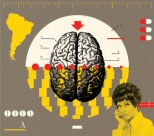 The Guardian has a curious report about “the latest drug to emerge from South America” which is supposedly “twice as powerful as crack cocaine at just a fraction of the price”. What the journalist doesn’t know, I suspect, is that this is a common form of cocaine paste that is widely known around the region.
The Guardian has a curious report about “the latest drug to emerge from South America” which is supposedly “twice as powerful as crack cocaine at just a fraction of the price”. What the journalist doesn’t know, I suspect, is that this is a common form of cocaine paste that is widely known around the region.
The article and video report tackle what is described as “a highly addictive mix of cocaine paste, gasoline, kerosene and quicklime called Oxi” that is supposedly highly hallucinogenic.
However, everything in the description of the drug and its appearance in the video seems to suggest it is just a new name for a widely used form of cheap cocaine paste known by the Spanish names basuco or paco.
For those not aware of how cocaine is produced from the coca leaf, a 1993 Forensic Science Review article (full-text mirrored here) outlined the usual stages of illegal manufacture.
Although ‘Oxi’ is described as including “gasoline, kerosene and quicklime” all of these are standard ingredients in the creation of cocaine paste itself, which itself is an intermediate stage in the production of powder or crack cocaine.
In fact, in the most common production process the subsequent stages just remove the unpleasant solvents, like gasoline and kerosene, from the cocaine paste to produce the purified product.
However, unrefined cocaine paste that still contains these chemicals is widely sold in South America as a cheap but nasty high. Refined cocaine is largely created for export but the paste mainly appears on the local market and is most prevalent in economically deprived areas.
It usually comes as a powder or as crack cocaine-like rocks that can be smoked for a short intense euphoria – which encourages frequent use – and a mid-brain dopamine boosting neurochemical profile that often induces paranoia and paranoid psychosis of exactly the sort described by users in the video.
My guess would be that ‘Oxi’ is just a new name being used to locally market this form of cocaine paste in the Brazilian area of the Amazon region whereas it is sold as basuco in the rest of the Spanish speaking areas.
Link to Guardian report about ‘Oxi’.
Link to mirror for paper on illegal cocaine production.
Link to search of scientific article on basuco (mainly in Spanish).


 The New York Times has an amazing
The New York Times has an amazing 

 I’ve written an
I’ve written an 
 The Providentia blog has a brilliant
The Providentia blog has a brilliant 
 I’ve got a brief
I’ve got a brief 

 We’ve covered a few cases of people swallowing unusual things before, although this is probably one of the strangest
We’ve covered a few cases of people swallowing unusual things before, although this is probably one of the strangest  A
A 